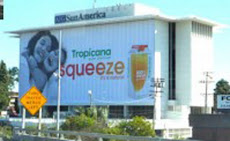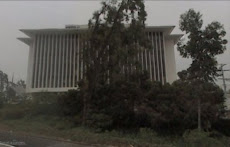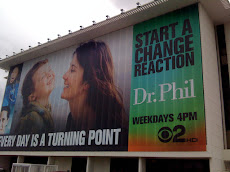By Michael Janofsky
Feb. 2 (Bloomberg) -- Andy Safir says he paid a premium for a view of the Santa Monica Mountains and Los Angeles skyline when he leased space for his economic consulting firm.
He was surprised one morning to find the office in shadows even though the sun was shining. While he traveled abroad, the side of the building had been draped with a giant Statue of Liberty in protest against a city sign moratorium on just that kind of display.
“I was horrified,” said Safir, president of Recon Research Corp. “What they effectively did was sell my view twice -- once to me, then to the sign company.”
So-called supergraphics, huge posters made of vinyl and mesh, can bring in $20,000 a month or more, said Paul Fisher, a lawyer in Newport Beach, California, who represents advertising firms and landlords in disputes with the city of Los Angeles.
That’s drawing landlords hungry for revenue, as vacancy rates rise for Los Angeles office buildings. Ads for Tropicana orange juice, Pepsi-Cola, Club Med and other products cover as much as 10 stories of building faces, including windows.
Tenants complain that the signs block their natural light, while other opponents say the banners clutter an urban landscape already filled with commercial messages. The city opposes some signs for safety reasons, and the fire department ordered removal of about 20, City Councilman Jack Weiss said at a news conference last week.
“Big signs mean big money,” said Safir, who initiated a lawsuit against his building over the sign. A federal court ruling in August that the signs are legal is being appealed. Outdoor advertising companies and property owners have filed about a dozen more lawsuits against the city in the meantime, challenging a Dec. 26 moratorium against all new signs to give local officials 90 days to rewrite regulations.
Loss of Revenue
The temporary ban is costing property owners millions of dollars, said Gary Mobley, a Newport Beach lawyer who represents one of the plaintiffs in a property owners’ lawsuit challenging the moratorium.
Supergraphics began appearing around Los Angeles about nine years ago when new printing techniques made them cheaper than using paint, Fisher said. The latest wave began last summer, after Judge Audrey Collins of the U.S. District Court for the Central District of California ruled that a 2002 ban on all signs was unconstitutional because city officials made exceptions to the restrictions.
More signs went up through the end of the year, as the deteriorating economy hurt office occupancy. Vacancies increased to 12.2 percent in the fourth quarter from 9.7 percent a year earlier, according to a report by real-estate broker Grubb & Ellis Co. in Santa Ana.
‘Unfair’ Attacks
Building owners “are being unfairly attacked for creating a revenue stream,” said Michael McNeilly, president of Sky Tag Inc. in Beverly Hills, the ad agency responsible for the Lady Liberty on Safir’s building at 6380 Wilshire Boulevard.
McNeilly said the sign was hung at no charge, to make the point that liberty is being subverted by the city’s moratorium while demonstrating that the building is available for paid ads. Four property managers whose buildings carry supergraphics didn’t return telephone messages seeking comment.
Anti-sign activists reject the argument that landlords should be cut any slack because of financial problems. Having vacancies doesn’t mean they’re permitted to install a machine shop or a house of prostitution in an office building, said Gerald Silver, president of a homeowners association in the Los Angeles suburb of Encino.
“You have to draw a line somewhere,” Silver said. “The line is drawn with a city ordinance that says it’s not lawful to have these signs.”
Movement on Blog
One sign-covered tenant is taking his protest campaign to a blog called 10801 Take Sign Down Now. David Allan, a chiropractor whose office at 10801 National Boulevard is covered by a Tropicana supergraphic, encourages readers to “voice your opinion and stand up against this insult and injustice.”
Supergraphics are central to Purchase, New York-based PepsiCo Inc.’s new campaign called Refresh Everything, said Larry Jabbonsky, a company spokesman. Tropicana is a PepsiCo brand.
“Big, spectacular outdoor advertising is an extremely important element” of Tropicana’s campaign, Bob Porcaro, group account director for Optimum Media Direct, a unit of New York- based Omnicom Media Group, wrote in an e-mail. He said the best way to showcase Tropicana packaging is “larger-than-life outdoor units that are going to be seen by millions of consumers.”
Having a supergraphic plastered across an edifice may be counterproductive for landlords, Safir said.
“I can’t imagine why a building would put up a sign that ticks off the tenants,” he said. “The last thing they want is for a tenant to move out.”
The Statue of Liberty covering his office was replaced Jan. 22 with a supergraphic depicting a camera viewfinder -- with holes cut out for the building windows.
To contact the reporter on this story: Michael Janofsky in Los Angeles at mjanofsky@bloomberg.net;
Last Updated: February 2, 2009 10:08 EST






No comments:
Post a Comment